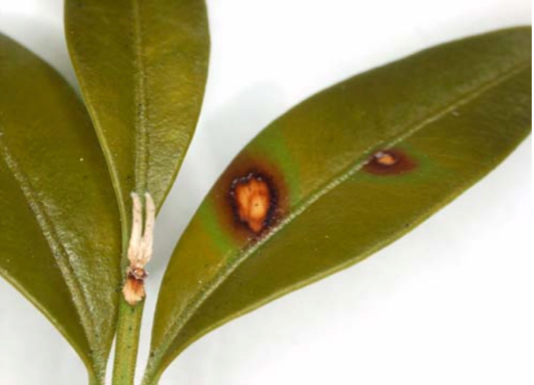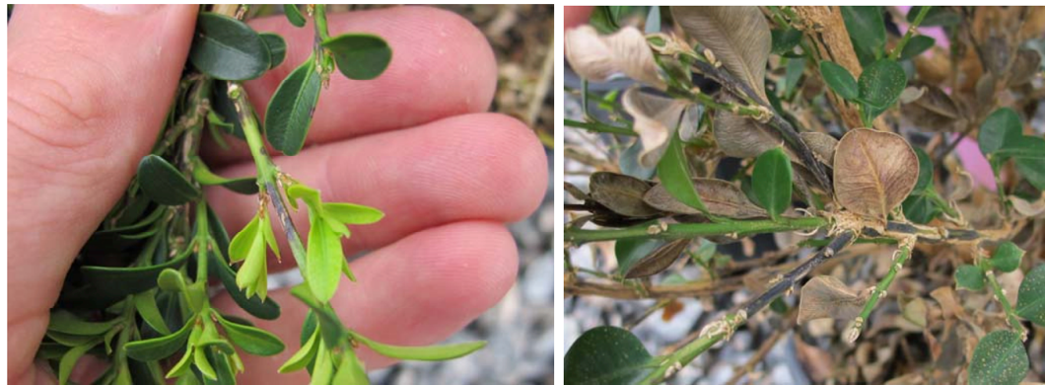Boxwood Blight Blues
go.ncsu.edu/readext?932645
en Español / em Português
El inglés es el idioma de control de esta página. En la medida en que haya algún conflicto entre la traducción al inglés y la traducción, el inglés prevalece.
Al hacer clic en el enlace de traducción se activa un servicio de traducción gratuito para convertir la página al español. Al igual que con cualquier traducción por Internet, la conversión no es sensible al contexto y puede que no traduzca el texto en su significado original. NC State Extension no garantiza la exactitud del texto traducido. Por favor, tenga en cuenta que algunas aplicaciones y/o servicios pueden no funcionar como se espera cuando se traducen.
Português
Inglês é o idioma de controle desta página. Na medida que haja algum conflito entre o texto original em Inglês e a tradução, o Inglês prevalece.
Ao clicar no link de tradução, um serviço gratuito de tradução será ativado para converter a página para o Português. Como em qualquer tradução pela internet, a conversão não é sensivel ao contexto e pode não ocorrer a tradução para o significado orginal. O serviço de Extensão da Carolina do Norte (NC State Extension) não garante a exatidão do texto traduzido. Por favor, observe que algumas funções ou serviços podem não funcionar como esperado após a tradução.
English
English is the controlling language of this page. To the extent there is any conflict between the English text and the translation, English controls.
Clicking on the translation link activates a free translation service to convert the page to Spanish. As with any Internet translation, the conversion is not context-sensitive and may not translate the text to its original meaning. NC State Extension does not guarantee the accuracy of the translated text. Please note that some applications and/or services may not function as expected when translated.
Collapse ▲Problems with your boxwoods? You are not alone. In fact, I’ve received several calls recently abut boxwoods that have been cherished in a homeowner’s gardens for decades, succumbing to problems and dying. This popular shrub can be a target for several pests and pathogens such as leafminers, wax scales, and other insects as well as spider mites, nematodes, and various root diseases. And not the least of which is Boxwood Blight.
If the problem is Boxwood leafminer the leaf’s lower surface appears “puffy” or blistered. Heavily infested plants have distorted and discolored leaves. If the problem is the Boxwood psyllid then the new growth appears distorted and cup shaped. Tiny (up to 3mm) pale-green insects feed inside distorted growth and secrete a fluffy, waxy covering; or small, green, leafhopper-like insects jump or fly onto foliage. If the boxwood is being attacked by the Japanese wax scale you will see white, waxy blobs up to 6 mm across show up on the limbs and twigs. They are often accompanied by a sooty (black) mold that feeds on the “honeydew” excreted by the scale. Spider mites are another opportunist that feeds on the boxwood. If they’re feeding on the bush the leaves are speckled with tiny, pale dots where the mite has sucked out the cell contents of that piece of leaf. The whole shrub may appear off-color, gray, or bronzed. There are 2 kinds to watch for: Twospotted spider mite where we see damage presenting as groups of single dots. The eggs are round and often reddish. Then there is the Boxwood spider mite where we see damage as tiny lines or “hen scratches” on the leaf surface. The eggs are flattened and yellowish.
Let’s not forget the Boxwood Blight. Most literature refers to the fungus that causes box blight as Cylindrocladium buxicola, sometimes also called, Calonectria pseudonaviculata. It was first reported in NC back in 2011. By 2019 twenty-six states had confirmed the disease. A very fast moving, contagious disease. The fungus can infect all aboveground portions of boxwood (it does not appear to affect the roots), causing severe defoliation and twig dieback. It’s an ugly business because the foliage typically becomes blighted and drops from the plant and you end up with a “skeleton” of the former plant. Symptoms of box blight include: dark‐ or light‐brown, circular leaf spots often with darker margins; dark stem cankers or ‘streaks’; straw‐ to bronze‐colored, blighted foliage; and leaf drop. Leaf spots may grow together to eventually cover the entire leaf.
Blighting and defoliation can occur quickly under warm (64 to 80°F) and humid conditions. Shady conditions favor disease development. Under high humidity, white fuzzy masses consisting of numerous spores can be seen on infected stems and leaves. You can see the actual spores under magnification. However, these fuzzy masses are often not observed if environmental conditions if relative humidity or temperatures are too low).
The stems of infected boxwood typically remain green under the outer bark until a secondary invader attacks this tissue and eventually kills the plant. Often that second attack comes from Volutella buxi to finish off the boxwood. NCSU’s research from 2012 indicated a wide range in susceptibility of boxwood cultivars to box blight, however B. sempervirens types were more susceptible in general, with Buxus sempervirens ‘Suffruticosa’ (English boxwood) and Buxus sempervirens ‘American’ (common or American boxwood) especially susceptible. Which are the varieties that have historically been planted in our area. The primary way this disease has spread was the movement of infected plants, cuttings, and boxwood debris (especially fallen leaves). However, a major way this disease currently spreads is through contaminated tools and workers. Pruning is a major transport activity. The sticky fungal spores are move on contaminated tools and equipment, on workers and animals that come into contact with infected foliage, and in water (in splashing rain or overhead irrigation, flood water, runoff water or in droplets carried by the wind).
A proper ID is essential to determine if your boxwood problem is due to blight. Look for circular spots on the leaves that have a dark brown to purple margin. Also, look for dark brown to black lesions or “streaks” on the stems. All plants infected with box blight should be destroyed, as the chance of further spreading this fungus is high.
ALWAYS following good sanitation practices to limit movement of this fungus. Use practices such as disinfecting pruners and other tools frequently within and between different blocks of plants, never working in the shrubs when the plants are wet; washing off debris and dirt entirely from soles of shoes between landscape areas; burning (if allowed in your area) or burying box‐blight infected plants (composting is not recommended); and NEVER discard boxwood waste material where it could contaminate other boxwood plants.
The best way to sanitize tools is to dip them for TEN SECONDS into these products and then allowing the tools to dry: ethyl or isopropyl alcohol at 70‐100% (most Lysol formulations, grain/rubbing alcohol), sodium hypochlorite (10% Clorox or other brands of household bleach‐ the same as 1 part bleach to 9 parts clean water‐ made fresh each day). For more information about resistant varieties or some protective strategies for non-infected plants contact me at minda_daughtry@ncsu.edu.





